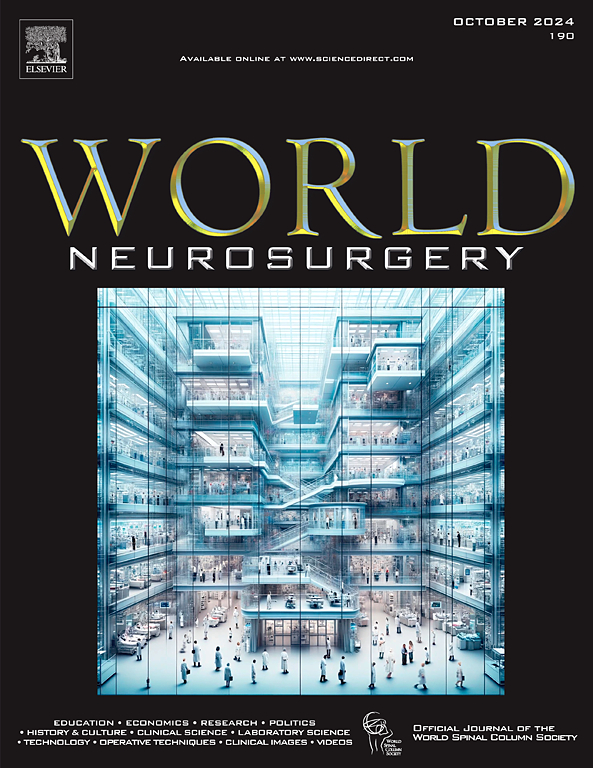用于颅骨成形术的抗菌生物材料:系统综述。
IF 1.9
4区 医学
Q3 CLINICAL NEUROLOGY
引用次数: 0
摘要
颅骨成形术是一种重建颅骨的外科手术,但它有很大的感染风险和随后的移植物失败。手术无菌、全身抗生素预防和局部抗菌剂可以降低这种风险,但最近的注意力集中在将抗菌剂或特性直接添加到植入物上或植入物中。本系统综述评估了抗菌改良颅骨成形术在降低感染风险方面的疗效。方法:根据注册方案,两位审稿人独立搜索和筛选描述抗菌改良颅骨成形术移植物的研究。纳入标准包括体外、体内和评估改变颅骨成形术植入物的临床研究(例如,抗生素或纳米颗粒嵌入、包被或添加到储存库中)。主要结局指标是适宜的感染指标,附加结果包括抗生素释放情况。结果:20项研究符合纳入标准:10项体外研究(2项也报道了体内模型的结果),10项临床研究(n=234例患者)。聚合物、陶瓷或水凝胶接枝被浸渍或涂覆各种抗菌剂,最常见的是氨基糖苷类。体外研究一致表明,局部抗生素浓度高,细菌定植减少,具有早期爆发和持续低水平洗脱的双相释放特征。在有限的体内研究中,全身药物水平仍然很低。临床研究报告合并并发症发生率为2.99%。虽然这可能表明历史并发症发生率有所改善,但大多数研究缺乏适当的比较物和足够的力量:只有一项研究试图与历史数据进行统计比较,发现感染发生率无显著降低(2.6% vs. 7.8%, p=0.179)。结论:颅骨成形术材料的抗菌修饰具有良好的局部释放特性和最小的全身分布,具有良好的临床前效果。早期临床经验表明可能降低感染率,但目前的证据受到样本量小和方法偏差的限制。为了确定明确的临床疗效并指导最佳的材料-抗生素组合和给药方法,设计良好、报告标准化的比较试验是必要的。本文章由计算机程序翻译,如有差异,请以英文原文为准。
Antimicrobial Biomaterials for Cranioplasty: A Systematic Review
Background
Cranioplasty is a surgical procedure performed to reconstruct the calvarium, yet it carries a significant risk of infection and subsequent graft failure. Surgical asepsis, systemic antibiotic prophylaxis, and topical antiseptics may reduce this risk, but recent attention has focused on incorporating antimicrobial agents or properties directly onto or into the implant. This systematic review assesses the efficacy of antibacterial-modified cranioplasty grafts in reducing infection risk.
Methods
Following a registered protocol, 2 reviewers independently searched and screened for studies describing antibacterial-modified cranioplasty grafts. Inclusion criteria included in vitro, in vivo, and clinical studies evaluating altered cranioplasty implants (e.g., antibiotics or nanoparticles embedded, coated, or added to a reservoir). The primary outcome measures were suitable measures of infection, with additional outcomes including antibiotic release profile.
Results
Twenty studies met the inclusion criteria: 10 in vitro studies (2 also reporting results of in vivo models) and 10 clinical studies (n = 234 patients). Polymeric, ceramic, or hydrogel grafts were impregnated or coated with various antimicrobial agents, most commonly aminoglycosides. In vitro studies consistently demonstrated high local antibiotic concentrations and reduced bacterial colonization, with a biphasic release profile characterized by an early burst and sustained low-level elution. In limited in vivo studies, systemic drug levels remained low. Clinical studies reported a combined complication rate of 2.99%. While this may indicate an improvement over historical complication rates, most studies lacked appropriate comparators and sufficient power: only 1 study attempted a statistical comparison with historical data, finding a nonsignificant reduction in infection (2.6% vs. 7.8%; P = 0.179).
Conclusions
Antimicrobial modifications to cranioplasty materials show promising preclinical results, with favorable local release profiles and minimal systemic distribution. Early clinical experiences suggest a possible reduction in infection rates, but the current evidence is limited by small sample sizes and methodological biases. Well-designed comparative trials with standardized reporting are necessary to establish definitive clinical efficacy and to guide optimal material-antibiotic combinations and delivery methods.
求助全文
通过发布文献求助,成功后即可免费获取论文全文。
去求助
来源期刊

World neurosurgery
CLINICAL NEUROLOGY-SURGERY
CiteScore
3.90
自引率
15.00%
发文量
1765
审稿时长
47 days
期刊介绍:
World Neurosurgery has an open access mirror journal World Neurosurgery: X, sharing the same aims and scope, editorial team, submission system and rigorous peer review.
The journal''s mission is to:
-To provide a first-class international forum and a 2-way conduit for dialogue that is relevant to neurosurgeons and providers who care for neurosurgery patients. The categories of the exchanged information include clinical and basic science, as well as global information that provide social, political, educational, economic, cultural or societal insights and knowledge that are of significance and relevance to worldwide neurosurgery patient care.
-To act as a primary intellectual catalyst for the stimulation of creativity, the creation of new knowledge, and the enhancement of quality neurosurgical care worldwide.
-To provide a forum for communication that enriches the lives of all neurosurgeons and their colleagues; and, in so doing, enriches the lives of their patients.
Topics to be addressed in World Neurosurgery include: EDUCATION, ECONOMICS, RESEARCH, POLITICS, HISTORY, CULTURE, CLINICAL SCIENCE, LABORATORY SCIENCE, TECHNOLOGY, OPERATIVE TECHNIQUES, CLINICAL IMAGES, VIDEOS
 求助内容:
求助内容: 应助结果提醒方式:
应助结果提醒方式:


